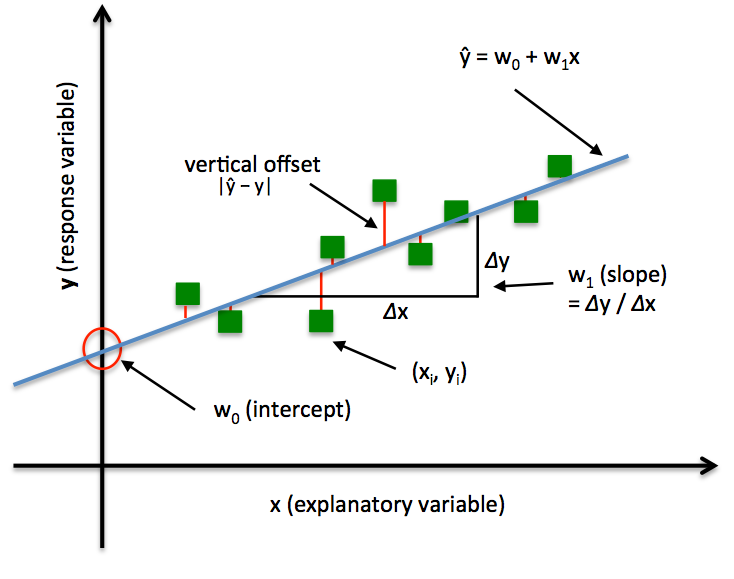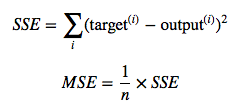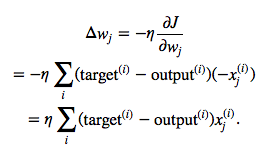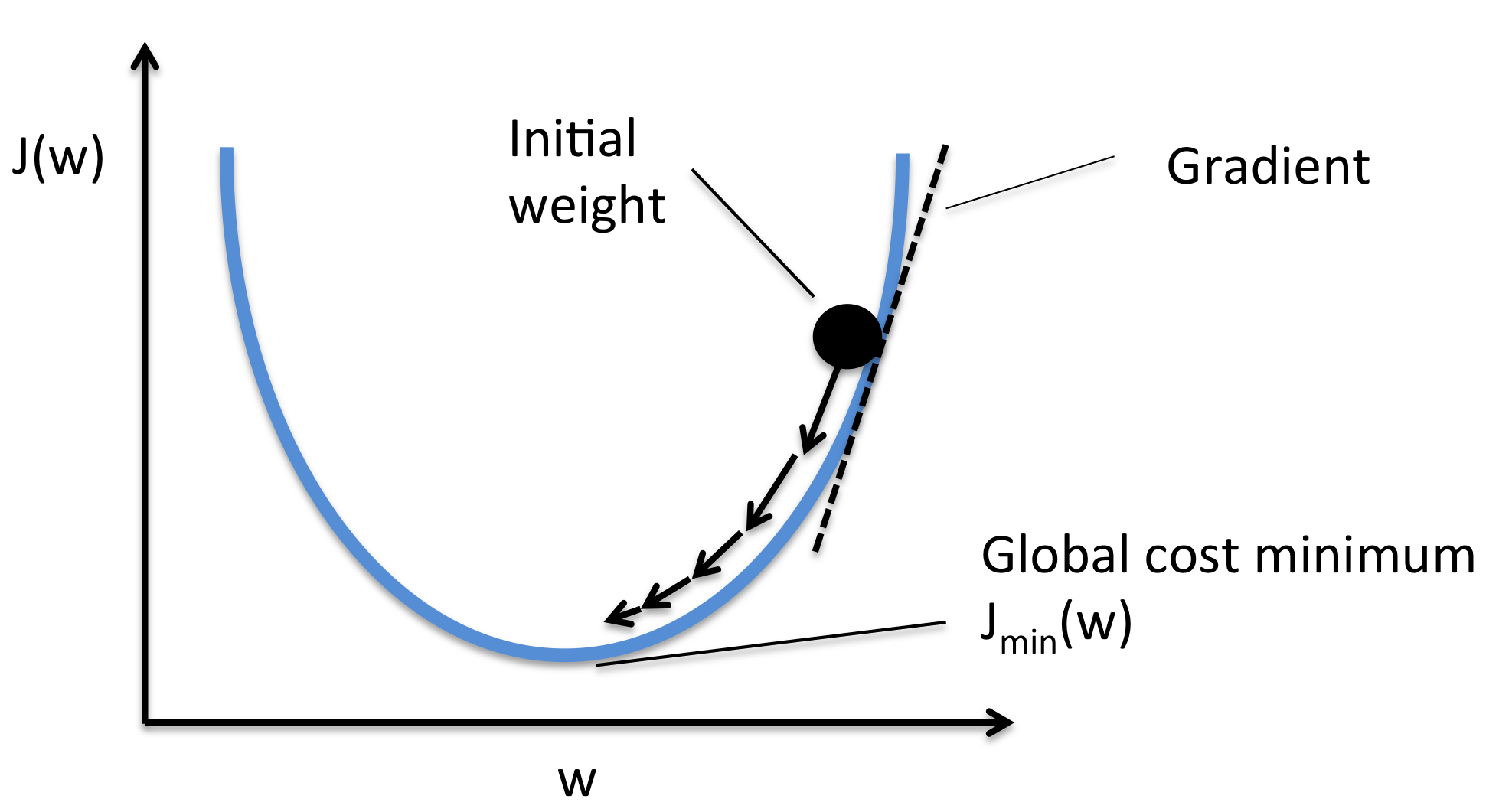FITTING A MODEL VIA CLOSED-FORM EQUATIONS VS. GRADIENT DESCENT VS STOCHASTIC GRADIENT DESCENT VS MINI-BATCH LEARNING. WHAT IS THE DIFFERENCE?
FITTING A MODEL VIA CLOSED-FORM EQUATIONS VS. GRADIENT DESCENT VS STOCHASTIC GRADIENT DESCENT VS MINI-BATCH LEARNING. WHAT IS THE DIFFERENCE?
In order to explain the differences between alternative approaches to estimating the parameters of a model, let's take a look at a concrete example: Ordinary Least Squares (OLS) Linear Regression. The illustration below shall serve as a quick reminder to recall the different components of a simple linear regression model:

In Ordinary Least Squares (OLS) Linear Regression, our goal is to find the line (or hyperplane) that minimizes the vertical offsets. Or, in other words, we define the best-fitting line as the line that minimizes the sum of squared errors (SSE) or mean squared error (MSE) between our target variable (y) and our predicted output over all samples i in our dataset of size n.

Now, we can implement a linear regression model for performing ordinary least squares regression using one of the following approaches:
- Solving the model parameters analytically (closed-form equations)
- Using an optimization algorithm (Gradient Descent, Stochastic Gradient Descent, Newton's Method, Simplex Method, etc.)
1) NORMAL EQUATIONS (CLOSED-FORM SOLUTION)
The closed-form solution may (should) be preferred for "smaller" datasets -- if computing (a "costly") matrix inverse is not a concern. For very large datasets, or datasets where the inverse of XTX may not exist (the matrix is non-invertible or singular, e.g., in case of perfect multicollinearity), the GD or SGD approaches are to be preferred. The linear function (linear regression model) is defined as:

where y is the response variable, x is an m-dimensional sample vector, and w is the weight vector (vector of coefficients). Note that w0 represents the y-axis intercept of the model and therefore x0=1. Using the closed-form solution (normal equation), we compute the weights of the model as follows:

2) GRADIENT DESCENT (GD)
Using the Gradient Decent (GD) optimization algorithm, the weights are updated incrementally after each epoch (= pass over the training dataset).
The cost function J(⋅), the sum of squared errors (SSE), can be written as:

The magnitude and direction of the weight update is computed by taking a step in the opposite direction of the cost gradient

where η is the learning rate. The weights are then updated after each epoch via the following update rule:

where Δw is a vector that contains the weight updates of each weight coefficient w, which are computed as follows:

Essentially, we can picture GD optimization as a hiker (the weight coefficient) who wants to climb down a mountain (cost function) into a valley (cost minimum), and each step is determined by the steepness of the slope (gradient) and the leg length of the hiker (learning rate). Considering a cost function with only a single weight coefficient, we can illustrate this concept as follows:

3) STOCHASTIC GRADIENT DESCENT (SGD)
In GD optimization, we compute the cost gradient based on the complete training set; hence, we sometimes also call itbatch GD. In case of very large datasets, using GD can be quite costly since we are only taking a single step for one pass over the training set -- thus, the larger the training set, the slower our algorithm updates the weights and the longer it may take until it converges to the global cost minimum (note that the SSE cost function is convex).
In Stochastic Gradient Descent (SGD; sometimes also referred to as iterative or on-line GD), we don't accumulate the weight updates as we've seen above for GD:

Instead, we update the weights after each training sample:

Here, the term "stochastic" comes from the fact that the gradient based on a single training sample is a "stochastic approximation" of the "true" cost gradient. Due to its stochastic nature, the path towards the global cost minimum is not "direct" as in GD, but may go "zig-zag" if we are visualizing the cost surface in a 2D space. However, it has been shown that SGD almost surely converges to the global cost minimum if the cost function is convex (or pseudo-convex)[1]. Furthermore, there are different tricks to improve the GD-based learning, for example:
An adaptive learning rate η Choosing a decrease constant d that shrinks the learning rate over time:

Momentum learning by adding a factor of the previous gradient to the weight update for faster updates:

A NOTE ABOUT SHUFFLING
There are several different flavors of SGD, which can be all seen throughout the literature. Let's take a look at the three most common variants:
A)
- randomly shuffle samples in the training set
- for one or more epochs, or until approx. cost minimum is reached
- for training sample i
- compute gradients and perform weight updates
- for training sample i
- for one or more epochs, or until approx. cost minimum is reached
B)
- for one or more epochs, or until approx. cost minimum is reached
- randomly shuffle samples in the training set
- for training sample i
- compute gradients and perform weight updates
- for training sample i
- randomly shuffle samples in the training set
C)
- for iterations t, or until approx. cost minimum is reached:
- draw random sample from the training set
- compute gradients and perform weight updates
- draw random sample from the training set
In scenario A [3], we shuffle the training set only one time in the beginning; whereas in scenario B, we shuffle the training set after each epoch to prevent repeating update cycles. In both scenario A and scenario B, each training sample is only used once per epoch to update the model weights.
In scenario C, we draw the training samples randomly with replacement from the training set [2]. If the number of iterationst is equal to the number of training samples, we learn the model based on a bootstrap sample of the training set.
4) MINI-BATCH GRADIENT DESCENT (MB-GD)
Mini-Batch Gradient Descent (MB-GD) a compromise between batch GD and SGD. In MB-GD, we update the model based on smaller groups of training samples; instead of computing the gradient from 1 sample (SGD) or all n training samples (GD), we compute the gradient from 1 < k < n training samples (a common mini-batch size is k=50).
MB-GD converges in fewer iterations than GD because we update the weights more frequently; however, MB-GD let's us utilize vectorized operation, which typically results in a computational performance gain over SGD.
REFERENCES
- [1] Bottou, Léon (1998). "Online Algorithms and Stochastic Approximations". Online Learning and Neural Networks. Cambridge University Press. ISBN 978-0-521-65263-6
- [2] Bottou, Léon. "Large-scale machine learning with SGD." Proceedings of COMPSTAT'2010. Physica-Verlag HD, 2010. 177-186.
- [3] Bottou, Léon. "SGD tricks." Neural Networks: Tricks of the Trade. Springer Berlin Heidelberg, 2012. 421-436.
FITTING A MODEL VIA CLOSED-FORM EQUATIONS VS. GRADIENT DESCENT VS STOCHASTIC GRADIENT DESCENT VS MINI-BATCH LEARNING. WHAT IS THE DIFFERENCE?的更多相关文章
- Python之路-(Django(csrf,中间件,缓存,信号,Model操作,Form操作))
csrf 中间件 缓存 信号 Model操作 Form操作 csrf: 用 django 有多久,我跟 csrf 这个概念打交道就有久了. 每次初始化一个项目时都能看到 django.middlewa ...
- 最大似然估计实例 | Fitting a Model by Maximum Likelihood (MLE)
参考:Fitting a Model by Maximum Likelihood 最大似然估计是用于估计模型参数的,首先我们必须选定一个模型,然后比对有给定的数据集,然后构建一个联合概率函数,因为给定 ...
- django 用model来简化form
django里面的model和form其实有很多地方有相同之处,django本身也支持用model来简化form 一般情况下,我们的form是这样的 from django import forms ...
- Django(八)下:Model操作和Form操作、序列化操作
二.Form操作 一般会创建forms.py文件,单独存放form模块. Form 专门做数据验证,而且非常强大.有以下两个插件: fields :验证(肯定会用的) widgets:生成HTML(有 ...
- Django(八)上:Model操作和Form操作
↑↑↑点上面的”+”号展开目录 Model和Form以及ModelForm简介 Model操作: 创建数据库表结构 操作数据库表 做一部分的验证 Form操作: 数据验证(强大) ModelForm ...
- day23 Model 操作,Form 验证以及序列化操作
Model 操作 1创建数据库表 定制表名: 普通索引: 创建两个普通索引,这样就会生成两个索引文件 联合索引: 为了只生成一个索引文件,才 ...
- [Angular2 Form] Reactive form: valueChanges, update data model only when form is valid
For each formBuild, formControl, formGroup they all have 'valueChanges' prop, which is an Observable ...
- 提高神经网络的学习方式Improving the way neural networks learn
When a golf player is first learning to play golf, they usually spend most of their time developing ...
- [C2P3] Andrew Ng - Machine Learning
##Advice for Applying Machine Learning Applying machine learning in practice is not always straightf ...
随机推荐
- JqueryMobile入门基础附源码下载
最近要做一个手机版的网站,所以就了解了一点JqueryMObile,下面是我整理的笔记,现在分享给大家,希望朋友们喜欢,先给个首页看看吧!!! 一.JqueryMobile基本页面结构 <!DO ...
- C# LUA 闭包
许多语言中有闭包的概念,C#的闭包以lambda表达式表现,可以实现与LUA完全一样的效果. //LUA------------------------------------------------ ...
- oracle文字与格式字符串不匹配的解决
oracle文字与格式字符串不匹配的解决 oracle的日期时间类型 在往oracle的date类型插入数据的时候,记得要用to_date()方法. 如insert into CUSLOGS(STAR ...
- 微信开放平台,微信登陆第三方网站 提示redirect_uri 参数错误
在微信开放平台上我填写的回调域是:bbs.qiaoshisui.com/LoginApi/WeiXinCallBack,我构造的链接是:https://open.weixin.qq.com/conne ...
- C#中小数点后保留两位小数,四舍五入的函数及使用方法
Math.Round(45.367,2) //Returns 45.37 Math.Round(45.365,2) //Returns 45.36 C#中的Round()不是我 ...
- struts 2.5.5 通配符问题
问题:使用通配符会报错,找不到action. 问题原因: struts2.5 为了增加安全性,在 struts.xml 添加了这么个属性:<global-allowed-methods>r ...
- iOS 苹果自带地图定位Core Location
Core Location是iOS SDK中一个提供设备位置的框架.可以使用三种技术来获取位置:GPS.蜂窝或WiFi.在这些技术中,GPS最为精准,如果有GPS硬件,Core Location将优先 ...
- GDB代码调试与使用
GDB代码调试与使用 Linux下GDB调试代码 源代码 编译生成执行文件 gcc -g test.c -o test 使用GDB调试 启动GDB:gdb test 从第一行列出源代码:list 直接 ...
- 有四中方法可以实现PHP的伪静态,你造吗?
说起伪静态的实现方案,你是不是很爽快的回答"简单,配置下apache的重写规则就行了嘛" 但是你有没有发现这种情况,你最近弄了很多新功能,每天上几个新功能,每天都有好多伪静态配置, ...
- 记<<ssh穿透防火墙连接内网的机器(不用路由端口映射)>>
场景: 在家连接公司的内网服务器. 需求: 不用设置端口映射在家用putty登录公司内网服务器. 条件: 有一台公网服务器做转发,有开放端口的控制权.(公网服务器可以是阿里云ECS, 腾讯云主机这样的 ...
